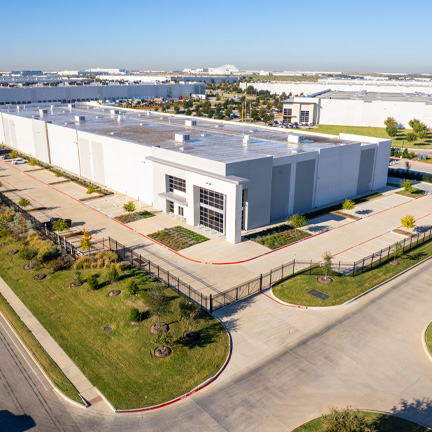Press

CenterPoint Properties Acquires Newly Constructed Fort Worth Distribution Facility
Search Site
Back to Menu

“The headline is industrial real estate is still very, very strong. It's probably one of the best-performing sectors of all. And if you look at the biggest firms, the ones that own the most assets, their share prices are at all-time highs. Their occupancies are high, their rental growth is high. All the metrics are really favorable. This is based on historically high leasing demand, and although debt costs are rising, they’re still historically low. Seems like lightning in a bottle to me.”
- Jim Clewlow, Chief Investment Officer
Read the full transcript of this in-depth interview teeming with Jim’s insights based on more than three decades of experience in the commercial real estate industry.
Commercial Property Exective: How did the industrial sector perform in the first quarter of 2022 compared to the same period of the previous year? Is there anything on the horizon that could stop the industrial boom in the near future? Please tell us a few details about the type of industrial assets that are most in-demand across the country right now and how has the pandemic impacted tenants’ needs and preferences?
Jim Clewlow: Two different answers, right now. In our business, there’s the capital market, and there’s the leasing market. The capital market is a little choppy compared to last year, meaning more investors today are worried about interest rates, double-digit inflation, Ukraine, and China. All of those add up to uncertainty, and capital doesn’t like uncertainty, right? So, where the market sees uncertainty, it sees risk and typically when there’s risk, yields go up. Couple that with an increase in investors’ borrowing costs, and it changes the outlook on how investors approach the business.
Regarding the leasing market – and leasing and capital markets aren’t always in lockstep, they’re two separate markets. Right now, leasing markets are crazy busy. Four things driving this are 1) the underlying economy is very, very strong 2) e-commerce continues to grow 3) businesses are shifting from a just-in-time inventory strategy to a just-in-case strategy and are building domestic safety stock 4) consumers are following businesses and are also stockpiling goods.
The fourth driver is the least understood but can have a major impact on leasing demand since consumers represent over 65 percent of U.S. GDP. Take Public Storage, for example. They are the largest public storage company in the U.S. If you look at their stock price, it has almost doubled basically in two years. I think people have said to themselves, ‘After COVID, I don’t want to run out next time there’s a shortage.’
These four drivers have contributed to an uber-strong leasing market bordering on euphoria that wasn’t driven by Amazon since they only leased half the amount of space in 2021 as they did in 2020. Now the question is, is this bull leasing market going to last two years, three years? Is it 100 percent secular? Some would argue the business and consumer stockpiling occurring today could come at the cost of inventory build-up years out. At this point, the capital markets haven’t figured that part of it out. All they’re dealing with right now is whether Estonia or Poland are next after Ukraine and whether the inflation we’re suffering from right now is transitory.
The headline is industrial real estate is still very, very strong. It’s probably one of the best-performing sectors of all. And if you look at the biggest firms, the ones that own the most assets, their share prices are at all-time highs. Their occupancies are high; their rental growth is high. All the metrics are really favorable. This is based on historically high leasing demand, and although debt costs are rising, they’re still historically low. Seems like lightning in a bottle to me.
CPE: Did construction delays caused by the pandemic impact the rental growth we’re seeing?
Jim: I think the short answer is yes, particularly in the most urban infill markets. It’s interesting that although there have been shortages of raw materials like labor, steel, and lumber and delays in entitlements, the pace of new construction across the country has been at historically high clips in 2019, 2020 and 2021. In fact, the square footage of new construction delivered in the U.S. in 2021 was an all-time high, according to Cushman & Wakefield. So, it’s really the demand side of the leasing equation that is driving the scarcity, and demand is most pronounced in the urban infill where it is most difficult to deliver. And shortages and delays have exacerbated already existing supply constraints in these markets.
In the urban infill of LA, the Inland Empire and New York/New Jersey, we see vacancies of almost 0 percent, but historically speaking, vacancies have always been low. To find opportunities to either build new construction or redevelop in these urban infill markets, we have maintained a long-term investment strategy of acquiring older properties that can be torn down or enhanced later.
In 2013, we acquired a building on 26 acres in Seattle that didn’t even have a roof. We knew how hard it was to find sites that large in the urban infill of South Seattle, and we liked the optionality of eventually making it a parking lot or building a new building. Land is so scarce there, the PLD built one of their first multi-story buildings in the country down the street. This year our development team knocked down the old roof-less building and is constructing a new single-story 400,000-square-foot building.
Historically the industrial sector has benefited from a shorter new construction delivery cycle time compared to other property sectors. In most cases, the delivery cycle for new construction can be 2-3 years and, in worst cases, 4-5 years. But in the office sector, there can be an eight-year to ten-year delivery cycle if you’re constructing an office building in the CBD. That means you’re forecasting leasing demand possibly almost a decade out. The shorter delivery cycle of new industrial construction is why markets have generally remained in balance during my 38-year career.
CPE: In CY ’21, CenterPoint spent more than $1.7 billion to acquire industrial assets. Does your expansion strategy for 2022 and beyond differ?
Jim: You’re right; at our fiscal year-end this June, we will have acquired $1.7 billion. Roughly 80 percent was invested in LA, the Inland Empire and New York/New Jersey. The rest was in Miami, Dallas, Austin and Oakland. For us, it’s about investing in markets that have the potential for the highest rental growth combined with the potential for the least amount of downtime. Over the last ten years, we have built significant positions in the urban infill of LA, the Inland Empire and New York/New Jersey. These are great places to invest in because they have huge populations, seaports and have limits on the introduction of new supply. We will continue to grow in these major gateway markets, but as we get bigger, we also need to diversify our risk into other markets, as well.
There’s a lot of talk lately about deglobalization. We’ve just experienced 30 years of rapid globalization through containerization and growing global trade. From 1999 to today, TEUs processed through LA/Long Beach ports grew by almost three times. But crises due to COVID, global trade disruption, Ukraine and recent Chinese aggression reminds us that global order can be disrupted. Increasingly, more companies are seeking manufacturing solutions in or closer to the U.S. These markets are active with manufacturing requirements from companies not wanting to rely on just-in-time deliveries from East and Southeast Asia. In Austin, for example, Samsung has a 2.45 million-square-foot semiconductor manufacturing plant that employs 2,500 employees, and they’re building a second one that will cost around $17 billion and employ 1,800 people. Also, in Austin, Tesla built its 4.5 million-square-foot Gigafactory, which will create over 20,000 jobs. In Phoenix, TSMC is building a $12 billion semiconductor manufacturing plant that will employ 1,600 people. These are all markets we are diversifying into, as the US increasingly will become an attractive option for high-tech manufacturing.
CPE: Phoenix and Southern California have also experienced significant investment activity lately. What makes each of these locations so appealing? What are your plans for these markets?
Jim: Southern California will always be attractive given the huge population, seaports, and supply constraints, as mentioned earlier. Phoenix is interesting given the consistent population growth, business-friendly climate, and relative proximity to Southern California. It’s only six hours to LA/Long Beach ports from Phoenix. San Diego is practically part of the LA metropolis, and many of the companies we serve in LA also are in San Diego.
CPE: Considering CenterPoint’s expansion from LA and Orange County southward now into San Diego, would you ever entertain buying property in Mexico to service San Diego users?
Jim: We entertained it very seriously back in 2007 and, after a very thorough investigation, elected not to do it. There are a lot of compelling reasons to be there though. A strong and burgeoning middle class and manufacturing sector, close affiliation with the U.S. and obviously proximity. Mexico will be a winner long-term and would benefit from deglobalization. Markets like Houston, San Antonio, Austin, and Laredo will benefit from their proximity to Mexico, too.
CPE: CenterPoint owns more than 5 million square feet of industrial space in Houston. What made you expand to Texas markets outside of Houston, such as Dallas or Austin?
Jim: Texas is growing rapidly demographically. Corporate users are moving there in droves. Manufacturing is moving there because it’s a business-friendly state. Port of Houston’s growth affects the entire state and, again, it’s adjacent to Mexico.
CPE: CenterPoint also entered the Pennsylvania market last year. What sparked your interest in that market? Do you plan to further expand your Northeast footprint? Have you set your eyes on any other metros in this region?
Jim: If you look at New York/New Jersey, land constraints are a real challenge for logistics and e-commerce companies. We believe in the Lehigh Valley market in a big way because it’s a natural extension of the New York/New Jersey market. It’s kind of like what the Inland Empire is for Los Angeles. Not quite as big as the Inland Empire, which is roughly 500 million square feet of warehouse space. This isn’t as big, but it has the potential of being very big, and it’s certainly very vibrant. We’ll be a long-term investor there.
CPE: And will CenterPoint stay in that Lehigh Valley, PA area, or will you go into other parts of Philadelphia?
Jim: We’re actively evaluating opportunities in Philadelphia. There is a megalopolis that’s forming between New York and Philly along I-95, and we have strong positions in Northern New Jersey and we’re moving southward. Like the Lehigh Valley market, it makes sense that we’d be in Philadelphia because it’s a natural extension of what’s happening in New York/New Jersey.
About CenterPoint Properties
CenterPoint is an industrial real estate company made up of dedicated thinkers, innovators and leaders with the creativity and know-how to tackle the industry’s toughest challenges. And it’s those kinds of problems — the delicate, the complex, the seemingly impossible — that we relish most. Because with an agile team, substantial access to capital and industry-leading expertise, those are exactly the kinds of problems we’re built to solve. For more information on CenterPoint Properties, follow us on LinkedIn. For all media inquiries, including requests for interviews with CenterPoint executives, please contact media@centerpoint.com or 630.586.8285.
For CenterPoint Investment inquiries, please contact:
Subscribe
Microsite Request